01/07/2010
Edinburgh is a city steeped in history. Over time, existing buildings have been substantially altered or demolished, while whole streets and areas have been razed and redeveloped. Meanwhile, many competition and design proposals have been produced for buildings and monuments which were never realised, and which could have fundamentally altered the current appearance of the city. So there are, in fact, three Edinburghs: the city as it was, the city as it is today, and 'Lost Edinburgh', the city as it might have been.
RCAHMS holds over 15 million items relating to the history of the built environment in Scotland. Our Collections contain a wide variety of items which demonstrate how Edinburgh has changed over time, and which show the 'Lost Edinburgh' which might have been, if things had been different. These include historic photographs, architectural plans and presentation drawings, engravings and sketches, competition entries and proposed designs for new developments, and aerial photographs from the Second World War taken by the RAF and the German Luftwaffe.
These examples show items from our Collections relating to the theme of Lost Edinburgh, and there are similar examples showing changes to urban and rural landscapes across the whole country.
Examples include:
• an artistic sketch of a view across Edinburgh from the 18th century
• a proposed plan for an “Improved Edinburgh” from 1831
• a proposed striking design by Basil Spence for the redevelopment of St James Square
• an historic sketch of Leith Harbour with 18th century fortification
• an historic aerial photograph of the Holyrood area where the Scottish Parliament now stands
• historic photographs of the Royal Infirmary including a view inside one of the working wards
• extravagant proposals for 19th century redevelopment of The Mound
• a painting of the temporary International Exhibition that was open in 1890
• photographs of the extensive Bonnington Mills before demolition





SC 357734
View of the Palace Hotel on Princes Street, Edinburgh the morning after being gutted by fire.
© RCAHMS

SC 358216
Engraving of the North Elevation of the old Royal Infirmary, Infirmary Street, Edinburgh. Copied from Vitruvius Scoticus Plate 150.
© RCAHMS

SC 361753
The Booking Hall at Waverley Station, Edinburgh showing mosaic floor, wooden booking office (now removed) and glass ceiling.
© RCAHMS

SC 417128
View of the house and gates of Rockville, 3 Napier Road, Edinburgh. Since demolished.
© RCAHMS


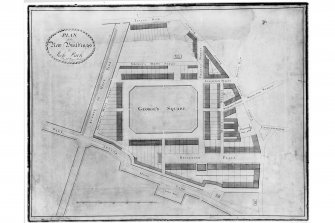


SC 426672
Engraving of the Luckenbooths beside St Giles' Cathedral, Edinburgh. Since demolished.
© RCAHMS

SC 436658
North area of Granton Gasworks, Edinburgh. General view from S of gasholders 2, 1 and 3 with Meter House (left) and Pumping Station (right). The red brick structure (right) is the remains of the redundant cooling water pumps. This has lost its wooden cooling tower. Left and right structures since demolished.
© RCAHMS

SC 457644
Plan of 'George's Square' in Edinburgh and the surrounding streets. Insc. 'Plan of the New Buildings in Rofs Park. By Jas. Brown Architect. 1779.'
© RCAHMS

SC 465068
Engraving of Tron Church, High Street, Edinburgh showing the original steeple. Copied from 'Views in Edinburgh and its Vicinity, Volume 2'. Insc. 'The Tron Church. Drawn, Eng.d & Pub.d by J & HS Storer, Chapel Street, Pentonville, April 1 1820'
© Courtesy of HES (Illustrations in 'Views in Edinburgh and its vicinity', J and H S Storer, 1820)


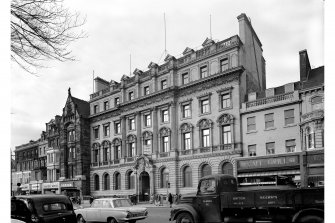


SC 465079
Engraving of Princes Street from Calton Hill, Edinburgh. Copied from 'Modern Athens'. Insc. 'Edinburgh, from the Calton Hill. Drawn by Tho. H Shepherd. Engraved by W Tombleson'.
© Courtesy of HES (Illustration from Modern Athens, T H Shepherd, 1829)

SC 465088
Engraving of North Bridge and Calton Hill from the Mound, Edinburgh. Copied from 'Modern Athens'. Insc. 'North Bridge, Calton Hill, &c. from the Bank of Scotland, Edinburgh. Drawn by Tho. H Shepherd. Engraved by S Lacy'.
© Courtesy of HES (Illustration from Modern Athens, T H Shepherd, 1829)

SC 466089
View from south east of North British Mercantile Ins. Co. Ltd and also showing Nos 63 and 70 - 75 Princes Street.
© Crown Copyright: HES (Scottish National Buildings Record)






SC 466176
The remains of burnt out buildings on the site of Jenners Department Store, South St David Street, Edinburgh.
© Courtesy of HES

SC 466179
100-104 Princes Street, Edinburgh including Boots the Chemist. Since demolished.
© Courtesy of HES (Scottish Colorfoto Collection)

SC 466234
Engraving of The Mound, Edinburgh showing New College. Titled: 'Mr Trotter of Dreghorns Plan for Improving the Mound'.
© RCAHMS

SC 601345
Birds-eye engraving of Edinburgh Royal Infirmary, taken from the Illustrated London News.
© Courtesy of HES (Illustrated London News)


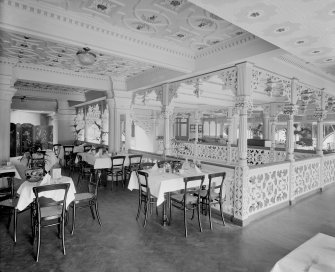


SC 621194
The Citadel Arch, Dock Street, Edinburgh with people. Since demolished.
© Courtesy of HES (Francis M Chrystal Collection)

SC 647741
Female ward 15 on the top floor of Edinburgh Royal Infirmary.
© Courtesy of HES (Survey of Private Collection. Dr G L Malcolm-Smith album)

SC 678374
The original tea room in Jenners Department Store in Edinburgh.
© Courtesy of HES (Bedford Lemere and Company Collection)

SC 680424
Edinburgh, Picture Theatre, interior. View of auditorium from stage.
© Courtesy of HES (Bedford Lemere and Company Collection)





SC 683059
32 Princes Street, Edinburgh, in use as Redfern Ltd Ladies Tailors, also showing Nos 30, 33 and 34 Princes Street. Since demolished.
© Courtesy of HES (Bedford Lemere and Company Collection)

SC 683063
The shop floor of Redferns Ltd Ladies Tailor, Edinburgh, with spinning wheel, chairs, parasols and fireplace. Since demolished.
© Courtesy of HES (Bedford Lemere and Company Collection)

SC 732572
The south side buildings on George Square, Edinburgh before demolition. Now the site of the University of Edinburgh library.
© Courtesy of HES (Records of Spence, Glover and Ferguson, architects, Edinburgh, Scotland)

SC 764374
Buildings on the South Bridge, Edinburgh shortly after a fire, being doused by firefighters. Since demolished.
© RCAHMS



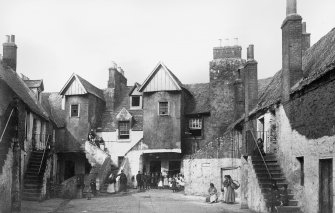

SC 932484
Engraving insc: "Trinity College Church, Edinburgh, South West view. Drawn by R.W.Billings. Engraved by J.H.Le.Keux. Edinburgh, Published by William Blackwood & Sons, 1847".
© RCAHMS

SC 932534
Engraving titled: 'The Netherbow Port from the East. Taken down 1764'. Insc: 'Drawn by D Wilson, Engraved by W Forrest'.
© RCAHMS

DP 005114
Unexecuted competition design for an obelisk in memory of Sir Walter Scott, with St John's Episcopal Church in the background, Edinburgh.
© Copyright: RIAS (William Henry Playfair Collection). Courtesy of HES.

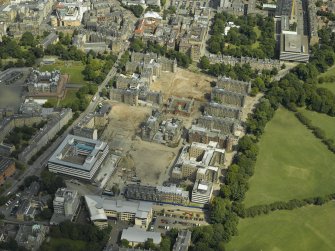




DP 010718
Aerial view of the old Edinburgh Royal Infirmary site during redevelopment with the dental institute adjacent, taken from the WSW.
© Crown Copyright: HES

DP 012989
Perspective drawing of proposed scheme for St James' Square redevelopment in Edinburgh. Unbuilt.
© Copyright: Sir Basil Spence Archive. Courtesy of HES.

SC 1034933
EPS/36/1 Photographic copy of photograph of part of McEwan Hall and Bristo Street, with text; 'Bristo Street, looking south, showing buildings demolished in 1897' Edinburgh Photographic Society Survey of Edinburgh and District, Ward XIV George Square
© Courtesy of HES (Edinburgh Photographic Society Collection)

SC 1082783
Historic view of Princes Street, Calton Gaol and Edinburgh Castle, seen from Calton Hill. Insc: 'Edinburgh from Calton Hill, J.Patrick'.
© RCAHMS





DP 034607
Drawing of the demolition of Parliament Square buildings in Edinburgh after a fire. Titled "Preparations for pulling down the Great Gable. Friday evening 19th Novr. Etched by W H Lizars".

SC 1098966
The glass cone at Salamander Street, Edinburgh during demolition.
© Courtesy of HES (Francis M Chrystal Collection)

SC 1100772
View from south east of 10 - 20 Princes Street with the Crown Hotel in foreground, before demolition.
© Courtesy of HES (Francis M Chrystal Collection)

SC 1100828
55, 57, 59 East Crosscauseway. View of street front, demolished tenements.
© Courtesy of HES (Francis M Chrystal Collection)

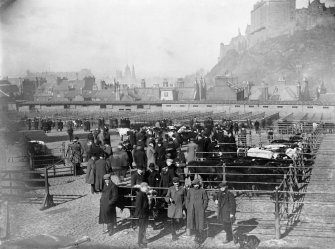



SC 1103837
James Souter's shop at Old Playhouse Close and Playhouse Close, Edinburgh. Since substantially remodelled.

SC 1111175
View of the old cattle market at Lauriston Place, Edinburgh, whilst in operation.
© Courtesy of HES (Edinburgh Photographic Society Collection)

SC 1116069
Engraving of plan and front elevation to court of Niddrie Marischal House, Edinburgh. Since demolished. Insc: 'The Generall Front of Niddrie House toward the Court the seat of Andrew Wauchope of Niddrie Esqr. in the county of Midlothian. Plan of the Mezzanine story, Plan of the Attick Story. Gul: Adam inc et delin, R. Cooper Sculpt'.
© RCAHMS

SC 1119845
The West End of Princes Street, Edinburgh showing buses, trams, cars and bicycles, pedestrians and a traffic warden.
© Courtesy of HES (Scottish Colorfoto Collection)






SC 1120420
Historic view of Waverley Market, Calton Hill and the site of the Balmoral Hotel, looking east from the Scott Monument, Edinburgh.
© Courtesy of HES (Photographs by Thomas Polson Lugton, photographer, Edinburgh, Scotland)

SC 1120460
View of Calton Hill and Calton Jail, Edinburgh looking over railway tracks and coal wagons at the eastern entrance to Waverley Station.
© Courtesy of HES (Scottish Colorfoto Collection)

SC 1120480
View of the Royal Patent Gymnasium in Royal Cresent Park, Edinburgh. It opened in 1865 but closed at the end of the century and was turned into a football ground. The circular device is a giant round boat allowing hundreds of people to row at the same time.
© Courtesy of HES (Scottish Colorfoto Collection)





SC 1122195
General view from South of Moray Free Church on Holyrood Road (now demolished)
© Courtesy of HES (Francis M Chrystal Collection)

DP 048136
Edinburgh, Murrayfield Stadium, oblique aerial view. This stadium has since been demolished.
© Copyright: HES (Aerofilms Collection)

SC 1129311
Historic view of Edinburgh taken from Blackford Hill showing Arthurs Seat, Salisbury Crags and Newington from west. The Grange area is mostly undeveloped at this stage.

SC 1140087
View of the stables and Hope Park United Free Chuch on the site now occupied by the Veterinary College. Edinburgh Photographic Society Survey of Edinburgh and District, Ward XIV George Square.
© Courtesy of HES (Edinburgh Photographic Society Collection)





SC 1140088
View of houses on the site now occupied by the Veterinary College. Edinburgh Photographic Society Survey of Edinburgh and District, Ward XIV George Square.
© Courtesy of HES (Edinburgh Photographic Society Collection)

SC 1151132
View of the old Edinburgh Royal Infirmary buildings across the Meadows, with sheep grazing.
© Courtesy of HES (Scottish Colorfoto Collection)

DP 065085
Oblique aerial view of the Canongate area, Edinburgh, c1951 including Holyrood Palace, the Meadow Flat Gas Holders (now the site of Dynamic Earth) and Holyrood Brewery (now the site of the Scottish Parliament).
© Copyright: HES (Aerofilms Collection)

SC 1167614
Historic view of Princes Street, Edinburgh showing Waverley Gardens and Scott Monument, trams, horse-drawn and motor traffic and pedestrians.
© Courtesy of HES (Scottish Colorfoto Collection)





SC 1171020
View of the Palace Cinema and 10-20 Princes Street, Edinburgh. Since demolished.
© Courtesy of HES (Scottish Colorfoto Collection)

SC 1171523
View of the junction of North Bridge and Princes Street, Edinburgh c1895. Now the site of the Balmoral Hotel.
© Courtesy of HES (Scottish Colorfoto Collection)

SC 1173466
View of central block during demolition of Royal Infirmary, Edinburgh. Titled: 'Edinburgh Infirmary'.
© RCAHMS

SC 1206636
View of 38-41 North Bridge, Edinburgh, showing the premises of Equitable Loan Company of Scotland, the Temperance Tea Rooms (no.41) and William Morton & Sons (no.40) and John Smith umbrella and parasol shop (no.38) as well as the entrance to Milne Square and part of the tram lines. All the buildings have since been demolished.
© Courtesy of HES (Scottish Colorfoto Collection)


DP 242215
View of houses at the head of College Wynd, Edinburgh, taken from a window in the University, prior to demolition.
© Courtesy of HES (W and R Chambers Collection)

SC 357734
View of the Palace Hotel on Princes Street, Edinburgh the morning after being gutted by fire.
© RCAHMS

SC 358216
Engraving of the North Elevation of the old Royal Infirmary, Infirmary Street, Edinburgh. Copied from Vitruvius Scoticus Plate 150.
© RCAHMS

SC 361753
The Booking Hall at Waverley Station, Edinburgh showing mosaic floor, wooden booking office (now removed) and glass ceiling.
© RCAHMS

SC 417128
View of the house and gates of Rockville, 3 Napier Road, Edinburgh. Since demolished.
© RCAHMS

SC 426672
Engraving of the Luckenbooths beside St Giles' Cathedral, Edinburgh. Since demolished.
© RCAHMS

SC 436658
North area of Granton Gasworks, Edinburgh. General view from S of gasholders 2, 1 and 3 with Meter House (left) and Pumping Station (right). The red brick structure (right) is the remains of the redundant cooling water pumps. This has lost its wooden cooling tower. Left and right structures since demolished.
© RCAHMS

SC 457644
Plan of 'George's Square' in Edinburgh and the surrounding streets. Insc. 'Plan of the New Buildings in Rofs Park. By Jas. Brown Architect. 1779.'
© RCAHMS

SC 465068
Engraving of Tron Church, High Street, Edinburgh showing the original steeple. Copied from 'Views in Edinburgh and its Vicinity, Volume 2'. Insc. 'The Tron Church. Drawn, Eng.d & Pub.d by J & HS Storer, Chapel Street, Pentonville, April 1 1820'
© Courtesy of HES (Illustrations in 'Views in Edinburgh and its vicinity', J and H S Storer, 1820)

SC 465079
Engraving of Princes Street from Calton Hill, Edinburgh. Copied from 'Modern Athens'. Insc. 'Edinburgh, from the Calton Hill. Drawn by Tho. H Shepherd. Engraved by W Tombleson'.
© Courtesy of HES (Illustration from Modern Athens, T H Shepherd, 1829)

SC 465088
Engraving of North Bridge and Calton Hill from the Mound, Edinburgh. Copied from 'Modern Athens'. Insc. 'North Bridge, Calton Hill, &c. from the Bank of Scotland, Edinburgh. Drawn by Tho. H Shepherd. Engraved by S Lacy'.
© Courtesy of HES (Illustration from Modern Athens, T H Shepherd, 1829)

SC 466089
View from south east of North British Mercantile Ins. Co. Ltd and also showing Nos 63 and 70 - 75 Princes Street.
© Crown Copyright: HES (Scottish National Buildings Record)

SC 466176
The remains of burnt out buildings on the site of Jenners Department Store, South St David Street, Edinburgh.
© Courtesy of HES

SC 466179
100-104 Princes Street, Edinburgh including Boots the Chemist. Since demolished.
© Courtesy of HES (Scottish Colorfoto Collection)

SC 466234
Engraving of The Mound, Edinburgh showing New College. Titled: 'Mr Trotter of Dreghorns Plan for Improving the Mound'.
© RCAHMS

SC 601345
Birds-eye engraving of Edinburgh Royal Infirmary, taken from the Illustrated London News.
© Courtesy of HES (Illustrated London News)

SC 621194
The Citadel Arch, Dock Street, Edinburgh with people. Since demolished.
© Courtesy of HES (Francis M Chrystal Collection)

SC 647741
Female ward 15 on the top floor of Edinburgh Royal Infirmary.
© Courtesy of HES (Survey of Private Collection. Dr G L Malcolm-Smith album)

SC 678374
The original tea room in Jenners Department Store in Edinburgh.
© Courtesy of HES (Bedford Lemere and Company Collection)

SC 680424
Edinburgh, Picture Theatre, interior. View of auditorium from stage.
© Courtesy of HES (Bedford Lemere and Company Collection)

SC 683059
32 Princes Street, Edinburgh, in use as Redfern Ltd Ladies Tailors, also showing Nos 30, 33 and 34 Princes Street. Since demolished.
© Courtesy of HES (Bedford Lemere and Company Collection)

SC 683063
The shop floor of Redferns Ltd Ladies Tailor, Edinburgh, with spinning wheel, chairs, parasols and fireplace. Since demolished.
© Courtesy of HES (Bedford Lemere and Company Collection)

SC 732572
The south side buildings on George Square, Edinburgh before demolition. Now the site of the University of Edinburgh library.
© Courtesy of HES (Records of Spence, Glover and Ferguson, architects, Edinburgh, Scotland)

SC 764374
Buildings on the South Bridge, Edinburgh shortly after a fire, being doused by firefighters. Since demolished.
© RCAHMS

SC 932484
Engraving insc: "Trinity College Church, Edinburgh, South West view. Drawn by R.W.Billings. Engraved by J.H.Le.Keux. Edinburgh, Published by William Blackwood & Sons, 1847".
© RCAHMS

SC 932534
Engraving titled: 'The Netherbow Port from the East. Taken down 1764'. Insc: 'Drawn by D Wilson, Engraved by W Forrest'.
© RCAHMS

DP 005114
Unexecuted competition design for an obelisk in memory of Sir Walter Scott, with St John's Episcopal Church in the background, Edinburgh.
© Copyright: RIAS (William Henry Playfair Collection). Courtesy of HES.

DP 010718
Aerial view of the old Edinburgh Royal Infirmary site during redevelopment with the dental institute adjacent, taken from the WSW.
© Crown Copyright: HES

DP 012989
Perspective drawing of proposed scheme for St James' Square redevelopment in Edinburgh. Unbuilt.
© Copyright: Sir Basil Spence Archive. Courtesy of HES.

SC 1034933
EPS/36/1 Photographic copy of photograph of part of McEwan Hall and Bristo Street, with text; 'Bristo Street, looking south, showing buildings demolished in 1897' Edinburgh Photographic Society Survey of Edinburgh and District, Ward XIV George Square
© Courtesy of HES (Edinburgh Photographic Society Collection)

SC 1082783
Historic view of Princes Street, Calton Gaol and Edinburgh Castle, seen from Calton Hill. Insc: 'Edinburgh from Calton Hill, J.Patrick'.
© RCAHMS

DP 034607
Drawing of the demolition of Parliament Square buildings in Edinburgh after a fire. Titled "Preparations for pulling down the Great Gable. Friday evening 19th Novr. Etched by W H Lizars".

SC 1098966
The glass cone at Salamander Street, Edinburgh during demolition.
© Courtesy of HES (Francis M Chrystal Collection)

SC 1100772
View from south east of 10 - 20 Princes Street with the Crown Hotel in foreground, before demolition.
© Courtesy of HES (Francis M Chrystal Collection)

SC 1100828
55, 57, 59 East Crosscauseway. View of street front, demolished tenements.
© Courtesy of HES (Francis M Chrystal Collection)

SC 1103837
James Souter's shop at Old Playhouse Close and Playhouse Close, Edinburgh. Since substantially remodelled.

SC 1111175
View of the old cattle market at Lauriston Place, Edinburgh, whilst in operation.
© Courtesy of HES (Edinburgh Photographic Society Collection)

SC 1116069
Engraving of plan and front elevation to court of Niddrie Marischal House, Edinburgh. Since demolished. Insc: 'The Generall Front of Niddrie House toward the Court the seat of Andrew Wauchope of Niddrie Esqr. in the county of Midlothian. Plan of the Mezzanine story, Plan of the Attick Story. Gul: Adam inc et delin, R. Cooper Sculpt'.
© RCAHMS

SC 1119845
The West End of Princes Street, Edinburgh showing buses, trams, cars and bicycles, pedestrians and a traffic warden.
© Courtesy of HES (Scottish Colorfoto Collection)

SC 1120420
Historic view of Waverley Market, Calton Hill and the site of the Balmoral Hotel, looking east from the Scott Monument, Edinburgh.
© Courtesy of HES (Photographs by Thomas Polson Lugton, photographer, Edinburgh, Scotland)

SC 1120460
View of Calton Hill and Calton Jail, Edinburgh looking over railway tracks and coal wagons at the eastern entrance to Waverley Station.
© Courtesy of HES (Scottish Colorfoto Collection)

SC 1120480
View of the Royal Patent Gymnasium in Royal Cresent Park, Edinburgh. It opened in 1865 but closed at the end of the century and was turned into a football ground. The circular device is a giant round boat allowing hundreds of people to row at the same time.
© Courtesy of HES (Scottish Colorfoto Collection)

SC 1122195
General view from South of Moray Free Church on Holyrood Road (now demolished)
© Courtesy of HES (Francis M Chrystal Collection)

DP 048136
Edinburgh, Murrayfield Stadium, oblique aerial view. This stadium has since been demolished.
© Copyright: HES (Aerofilms Collection)

SC 1129311
Historic view of Edinburgh taken from Blackford Hill showing Arthurs Seat, Salisbury Crags and Newington from west. The Grange area is mostly undeveloped at this stage.

SC 1140087
View of the stables and Hope Park United Free Chuch on the site now occupied by the Veterinary College. Edinburgh Photographic Society Survey of Edinburgh and District, Ward XIV George Square.
© Courtesy of HES (Edinburgh Photographic Society Collection)

SC 1140088
View of houses on the site now occupied by the Veterinary College. Edinburgh Photographic Society Survey of Edinburgh and District, Ward XIV George Square.
© Courtesy of HES (Edinburgh Photographic Society Collection)

SC 1151132
View of the old Edinburgh Royal Infirmary buildings across the Meadows, with sheep grazing.
© Courtesy of HES (Scottish Colorfoto Collection)

DP 065085
Oblique aerial view of the Canongate area, Edinburgh, c1951 including Holyrood Palace, the Meadow Flat Gas Holders (now the site of Dynamic Earth) and Holyrood Brewery (now the site of the Scottish Parliament).
© Copyright: HES (Aerofilms Collection)

SC 1167614
Historic view of Princes Street, Edinburgh showing Waverley Gardens and Scott Monument, trams, horse-drawn and motor traffic and pedestrians.
© Courtesy of HES (Scottish Colorfoto Collection)

SC 1171020
View of the Palace Cinema and 10-20 Princes Street, Edinburgh. Since demolished.
© Courtesy of HES (Scottish Colorfoto Collection)

SC 1171523
View of the junction of North Bridge and Princes Street, Edinburgh c1895. Now the site of the Balmoral Hotel.
© Courtesy of HES (Scottish Colorfoto Collection)

SC 1173466
View of central block during demolition of Royal Infirmary, Edinburgh. Titled: 'Edinburgh Infirmary'.
© RCAHMS

SC 1206636
View of 38-41 North Bridge, Edinburgh, showing the premises of Equitable Loan Company of Scotland, the Temperance Tea Rooms (no.41) and William Morton & Sons (no.40) and John Smith umbrella and parasol shop (no.38) as well as the entrance to Milne Square and part of the tram lines. All the buildings have since been demolished.
© Courtesy of HES (Scottish Colorfoto Collection)

DP 242215
View of houses at the head of College Wynd, Edinburgh, taken from a window in the University, prior to demolition.
© Courtesy of HES (W and R Chambers Collection)




